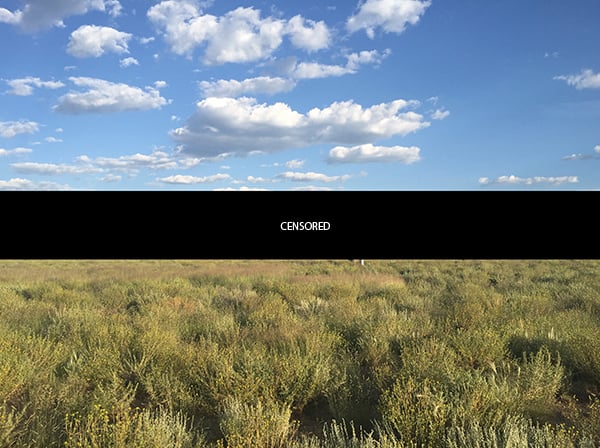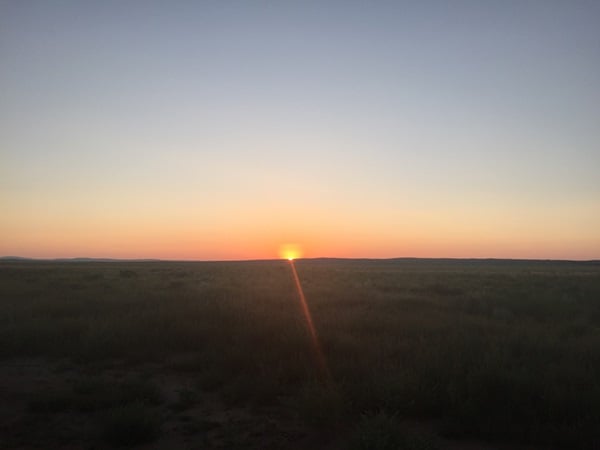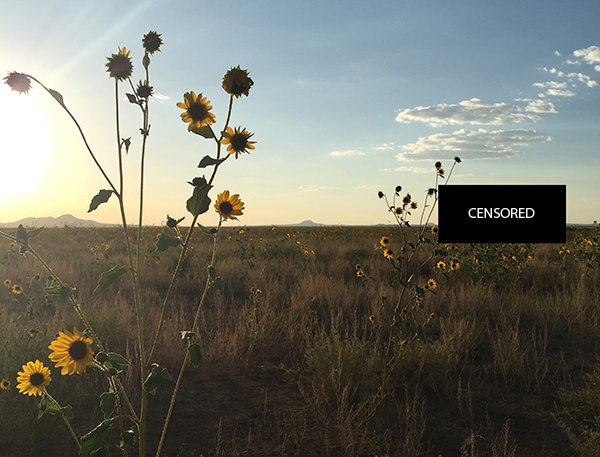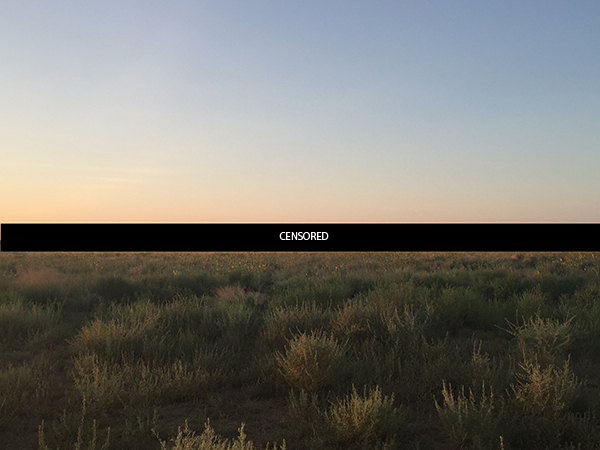Art World
How to Lose Yourself in ‘The Lightning Field’: A Photographic Adventure
The installation is too vital to remain elitist.

Photo: Courtesy of Karen Wong.
The installation is too vital to remain elitist.

Karen Wong


Sunrise.
Photo: Courtesy of Karen Wong.
We fly to Albuquerque, New Mexico and then drive two and a half hours to the town of Quemado, population 300. We park our car in front of the unlocked Dia Art Foundation office on the main street, the only street, and wait for the caretaker to pull up. Bags are transferred to his SUV and after a 40-minute drive, the last half on an unmarked road, we are dropped off in front of a log cabin that sleeps six. Dinner and breakfast are in the fridge and he informs us that cell service is nonexistent. There is a landline in the house and in case of an emergency, we can call him because he lives just 20 minutes away.
It’s mid-afternoon and it is hard to make out the silver poles that melt into the bright sunlight from Walter De Maria‘s 1977 installation The Lightning Field. It’s two parts rural paradise and one part science fiction here. The word “vast” is an understatement as I walk among these perfectly parallel, planted spikes. I murmur to myself that it’s possible a UFO from Roswell will touch down soon and abduct me.
As the sun starts to set, the field begins to glitter. The artwork is dancing, and we see it anew. As dusk settles in, we sit down for dinner. I challenge my precocious cello playing, 11-year-old goddaughter to select classical music from her iPod that sounds sadder than Miles Davis’s “Flamenco Sketches.”
We return outside to a black-blue sky that is aburst with stars. No one searches for the Milky Way because it is in plain sight. My goddaughter’s equally precocious older brother points out a number of constellations. I pretend to see them all.
We cap off our night screaming at the top of our lungs to his favorite song of the trip, the Talking Heads’ “Psycho Killer.” He and his sister are in stitches every time they hear David Byrne spit out the lines:
Qu’est-ce que c’est
Fa-fa-fa-fa-fa-fa-fa-fa-fa-far better
Run run run run run run run away…
We are all up just before sunrise. The summer daytime dry heat is replaced by a damp morning chill. Wrapped in our blankets, we perch ourselves on a couple of wooden benches. Everyone is nursing a coffee or hot chocolate. The bunny rabbits that live under the cabin are frolicking about. The light is hazy and the mountains in the distance a fading lilac. And then the sun emerges in silky fashion through the horizon line and The Lightning Field turns an orange pink. It’s unrecognizable from the previous day’s transitions and my mouth is agape.
I’ve been in the presence of this work for 18 hours. I have admonished myself that I underappreciate the natural beauty of the everyday and wrestled with the nature of love and how fleeting it can be. I’ve thought continuously of what did De Maria want his lonely guests to get out of his work? That perhaps this is still a spectacle, but one that is durational, sometimes ablaze and sometimes a ghost. I speculate, if there are any young artists working today that have the fortitude, the patience to realize a work that is about a lifetime.
In an era when any moment, mundane or monumental, is Instagrammable, The Lightning Field defies status quo. Everything about this magnum opus is slow, and requires your attention. De Maria conceived of the work in a note in 1969. He spent five years travelling Arizona, California, Nevada, Texas, and Utah and finally settled on a field in Western New Mexico that met his specifications. He prototyped the artwork with just 35 stainless steel rods in 1974 and realized the complete work of 400 in a grid that is a mile long and a kilometer wide in 1977.

Lightning Field.
Photo: Courtesy of Karen Wong.
I have a bunch of snaps on my iPhone. I can’t publish or post them because the artwork is protected by copyright; as it states in bold on Dia’s site, “Photography of the sculpture and cabin is not permitted.” Instead, “Sets of seven postcards of commissioned, copyrighted images of The Lightning Field and other works by Walter De Maria are available for purchase.”

Lightning Field.
Photo: Courtesy of Karen Wong.
Maybe that’s great because it emphasizes the importance of the on-site visit as one of profundity and poetry. And maybe it is not, because images, no matter how good or bad, are an expression of our experience and when we post and publish we bring in a group of friends to see what we saw. Sometimes we are bragging, sometimes we are connecting. It doesn’t matter.

Lightning Field.
Photo: Courtesy of Karen Wong.
The Lightning Field is too vital to remain an elitist art adventure. How wonderful if the demand meant that this work would be open all year? And how appropriate if the loyal public was trusted to share and educate one another on one of the most mesmerizing artworks of the second half of the 20th century?
Qu’est-ce que c’est
What is this that this is?
*Cosmic footnote: “Psycho Killer” was recorded in 1977 and appears on the album Talking Heads: 77.
Karen Wong is the Deputy Director of the New Museum in New York.